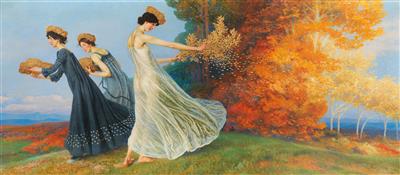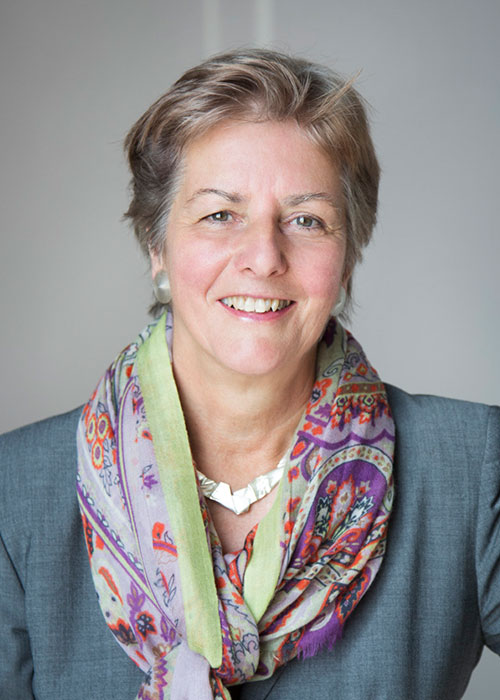Maximilian Lenz

(Vienna 1860–1948)
“Herbstgold”, on the reverse under a felt-tip line titled and inscribed M. Lenz, signed, inscribed and dated M. Lenz Wien 1905, oil with gold relief on canvas, 102 x 230.5 cm, framed (frame slightly damaged), (W)
We are grateful to Dr. Hella Buchner-Kopper for confirming the authenticity and her kind assistance by cataloging of this work.
Counterpart to lot 554
Maximilian Lenz started to attend the University of Applied Arts in Vienna aged just 14, and was accepted into Vienna’s Academy of Fine Arts three years later. After completing his studies, he received a scholarship to travel to Rome for two years. At the start of the 1890s, he travelled to Buenos Aires to work on a professional project along with the copper engraver Ferdinand Schirnböck (1859-1930). After returning to Vienna, he became a member of Vienna’s Künstlerhaus in 1896, and was one of the founding members of the Vienna Secession from 1897 onwards, remaining involved until 1939. In 1903, he journeyed to Italy with Gustav Klimt, where he visited Ravenna. There, he studied the gold-heavy Byzantine mosaics of San Vitale, which had a short-term (if not longer) impact on his art.
After this journey, Lenz moved to Lower Austria in 1904 where he was employed by the well-to-do Kupelwieser family as a drawing instructor. Ida Kupelwieser (1870-1927) was one of the most talented members of the family, and Lenz married her when he was 66, but she died shortly after the wedding.
Lenz used a range of techniques throughout his oeuvre and did not develop a fixed style that remained with him throughout his life. Rather, he adapted an individual design for each of the various media and works. After losing his wife, he was unable to find his way back into independent work and designed posters for war bonds during the First World War.
Maximilian Lenz’ artistic peak came when he found inspiration in the Kupelwieser family. These two pieces originate from this period. The sculptural gold accents are testament to the ideas he picked up from Gustav Klimt and the impressions he gathered on his trip to Italy. The two large-format images are dominated by an appealing colour palette and clear composition. The lively dancing ladies are gathered for a round dance and are listening to the “Altes Lied” (old song) played by the flautist (Lot 554). The sweeping landscape stretches across the background, making it possible to recognise it as the region surrounding Lake Lunz. The warm colours give the viewer the sense of a mild autumn day. The slightly distorted rear-view figure represents the connection between the animated rustling leaves and the wreath-bearers disappearing into the distance. Maximilian Lenz studied the figures for this work in great detail, as can be seen in sketches of the wreath-bearers. The two paintings immerse the viewers in an idyllic world and invite their gaze to linger a while.
Esperta: Dr. Christl Wolf
 Dr. Christl Wolf
Dr. Christl Wolf
+43-1-515 60-377
19c.paintings@dorotheum.at
24.10.2018 - 18:00
- Prezzo realizzato: **
-
EUR 68.750,-
- Stima:
-
EUR 18.000,- a EUR 25.000,-
Maximilian Lenz
(Vienna 1860–1948)
“Herbstgold”, on the reverse under a felt-tip line titled and inscribed M. Lenz, signed, inscribed and dated M. Lenz Wien 1905, oil with gold relief on canvas, 102 x 230.5 cm, framed (frame slightly damaged), (W)
We are grateful to Dr. Hella Buchner-Kopper for confirming the authenticity and her kind assistance by cataloging of this work.
Counterpart to lot 554
Maximilian Lenz started to attend the University of Applied Arts in Vienna aged just 14, and was accepted into Vienna’s Academy of Fine Arts three years later. After completing his studies, he received a scholarship to travel to Rome for two years. At the start of the 1890s, he travelled to Buenos Aires to work on a professional project along with the copper engraver Ferdinand Schirnböck (1859-1930). After returning to Vienna, he became a member of Vienna’s Künstlerhaus in 1896, and was one of the founding members of the Vienna Secession from 1897 onwards, remaining involved until 1939. In 1903, he journeyed to Italy with Gustav Klimt, where he visited Ravenna. There, he studied the gold-heavy Byzantine mosaics of San Vitale, which had a short-term (if not longer) impact on his art.
After this journey, Lenz moved to Lower Austria in 1904 where he was employed by the well-to-do Kupelwieser family as a drawing instructor. Ida Kupelwieser (1870-1927) was one of the most talented members of the family, and Lenz married her when he was 66, but she died shortly after the wedding.
Lenz used a range of techniques throughout his oeuvre and did not develop a fixed style that remained with him throughout his life. Rather, he adapted an individual design for each of the various media and works. After losing his wife, he was unable to find his way back into independent work and designed posters for war bonds during the First World War.
Maximilian Lenz’ artistic peak came when he found inspiration in the Kupelwieser family. These two pieces originate from this period. The sculptural gold accents are testament to the ideas he picked up from Gustav Klimt and the impressions he gathered on his trip to Italy. The two large-format images are dominated by an appealing colour palette and clear composition. The lively dancing ladies are gathered for a round dance and are listening to the “Altes Lied” (old song) played by the flautist (Lot 554). The sweeping landscape stretches across the background, making it possible to recognise it as the region surrounding Lake Lunz. The warm colours give the viewer the sense of a mild autumn day. The slightly distorted rear-view figure represents the connection between the animated rustling leaves and the wreath-bearers disappearing into the distance. Maximilian Lenz studied the figures for this work in great detail, as can be seen in sketches of the wreath-bearers. The two paintings immerse the viewers in an idyllic world and invite their gaze to linger a while.
Esperta: Dr. Christl Wolf
 Dr. Christl Wolf
Dr. Christl Wolf
+43-1-515 60-377
19c.paintings@dorotheum.at
|
Hotline dell'acquirente
lun-ven: 10.00 - 17.00
kundendienst@dorotheum.at +43 1 515 60 200 |
| Asta: | Dipinti dell’Ottocento |
| Tipo d'asta: | Asta in sala |
| Data: | 24.10.2018 - 18:00 |
| Luogo dell'asta: | Wien | Palais Dorotheum |
| Esposizione: | 13.10. - 24.10.2018 |
** Prezzo d’acquisto comprensivo dei diritti d’asta acquirente e IVA
Non è più possibile effettuare un ordine di acquisto su Internet. L'asta è in preparazione o è già stata eseguita.
